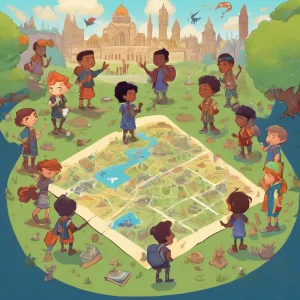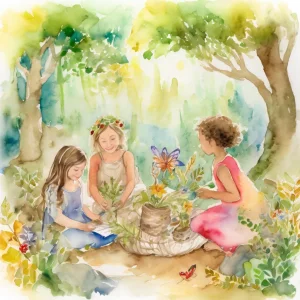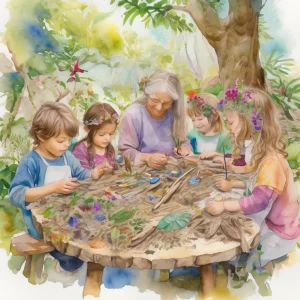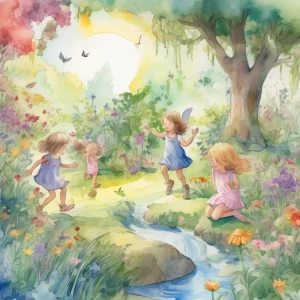Activity
Similar Activities
Digital Beats and Hoop Dreams Coding Adventure
Children’s Age: 9–12 years
Activity Duration: 10 – 20 minutes
An engaging coding activity integrating music production, basketball skills, and teamwork for children aged 9-12 years.
Activity Duration: 10 – 20 minutes
The Global Treasure Hunt: Cultural Adventure Quest
Children’s Age: 9–11 years
Activity Duration: 10 – 30 minutes
Get ready for an exciting Global Treasure Hunt adventure! You'll explore different countries, solve clues, and work together in teams. All you need is a map, some clues, and a sens…
Activity Duration: 10 – 30 minutes
Space Adventure Obstacle Course: Galactic Learning Journey
Children’s Age: 6–12 years
Activity Duration: 25 minutes
Get ready for an awesome adventure with the Space Adventure Obstacle Course! You'll crawl through cardboard box spaceships, jump over paper tube asteroids, and follow colorful tape…
Activity Duration: 25 minutes
Cosmic Harmonies: Music from Space Journey
Children’s Age: 10–12 years
Activity Duration: 40 minutes
"Music from Space" is an engaging activity tailored for children aged 10-12, combining fun and education to promote academic growth, empathy, and ecological awareness. Participants…
Activity Duration: 40 minutes
Enchanted Forest Tales: Nature Play Theater
Children’s Age: 4–6 years
Activity Duration: 15 – 25 minutes
Engage children aged 48 to 72 months in the "Nature Play Theater" activity, fostering communication skills and ecological awareness. Set up an outdoor performance area with natural…
Activity Duration: 15 – 25 minutes
Eco-Friendly Math Adventure: Crafting Math Tools & Challenges
Children’s Age: 6–7 years
Activity Duration: 30 minutes
Embark on the 'Eco-Friendly Math Adventure' for a blend of learning and eco-awareness! Gather recycled materials like cardboard, markers, and glue. Guide kids to create eco-friendl…
Activity Duration: 30 minutes
Enchanted Harmony: Musical Coding Adventure
Children’s Age: 11–15 years
Activity Duration: 45 minutes
Engage children aged 11-15 in a "Musical Coding Adventure" that blends music, coding, and physical activity. Set up musical instruments, coding cards, and open space for a fun and …
Activity Duration: 45 minutes
Symmetry Magic: Reflective Art Adventure
Children’s Age: 7–10 years
Activity Duration: 10 – 25 minutes
This activity involves exploring symmetry through a creative and interactive art project for children aged 7-10 years.
Activity Duration: 10 – 25 minutes
Empathy Journey: Cultural Balance Relay Race Adventure
Children’s Age: 6–9 years
Activity Duration: 25 – 30 minutes
The Cultural Balance Relay Race activity encourages empathy, teamwork, and cultural understanding in children. Set up the course with flags, cones, ecosystem visuals, and music for…
Activity Duration: 25 – 30 minutes
Enchanted Garden: Nature Sculpture Garden Adventure
Children’s Age: 4–6 years
Activity Duration: 10 – 25 minutes
Engage children aged 48 to 72 months in the "Nature Sculpture Garden" activity, promoting creativity and empathy. Using natural materials like sticks and leaves, along with clay an…
Activity Duration: 10 – 25 minutes
Whispers of the Meadow: Ball Toss and Talk
Children’s Age: 1.5–2 years
Activity Duration: 5 minutes
"Ball Toss and Talk" is a fun activity designed for children aged 18 to 24 months to boost language skills through sports and physical play. All you need is a soft ball and a safe,…
Activity Duration: 5 minutes
Enchanted Forest: Animal Hunt Adventure Discovery
Children’s Age: 5–7 years
Activity Duration: 15 – 25 minutes
"Animal Hunt Adventure" is an engaging outdoor activity that promotes cognitive development, self-care, and communication skills for children aged 5 to 7. With printed animal pictu…
Activity Duration: 15 – 25 minutes


























